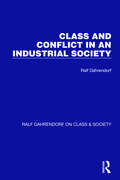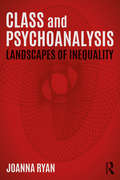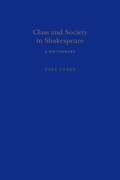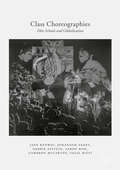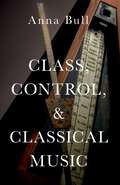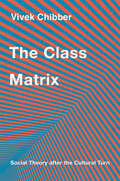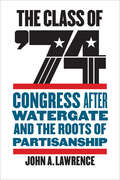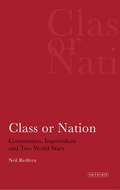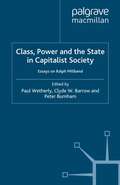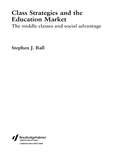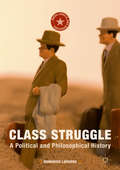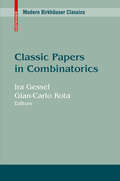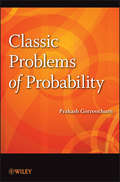- Table View
- List View
Class and Conflict in an Industrial Society (Ralf Dahrendorf on Class & Society #1)
by Ralf DahrendorfOriginally published in England in 1959, this book evolves a new theory of conflict in industrial society. By way of illustrating and testing this theory, the book provides detailed analyses of various social phenomena. The author carries out a full critique of Marx in the light of history and modern sociology and discusses the theories of class-conflict of James Burnham, Fritz Croner and Karl Renner.
Class and Psychoanalysis: Landscapes of Inequality
by Joanna RyanDoes psychoanalysis have anything to say about the emotional landscapes of class? How can class-inclusive psychoanalytic projects, historic and contemporary, inform theory and practice? Class and psychoanalysis are unusual bedfellows, but this original book shows how much is to be gained by exploring their relationship. Joanna Ryan provides a comprehensively researched and challenging overview in which she holds the tension between the radical and progressive potential of psychoanalysis, in its unique understandings of the unconscious, with its status as a mainly expensive and exclusive profession. Class and Psychoanalysis draws on existing historical scholarship, as well as on the experiences of the author and other writers in free or low-cost projects, to show what has been learned from transposing psychoanalysis into different social contexts. The book describes how class, although descriptively present, was excluded from the founding theories of psychoanalysis, leaving a problematic conceptual legacy that the book attempts to remedy. Joanna Ryan argues for an interdisciplinary approach, drawing on modern sociological and psychosocial research to understand the injuries of class, the complexities of social mobility, and the defenses of privilege. She brings together contemporary clinical writings with her own research about class within therapy relationships to illustrate the anxieties, ambivalences and inhibitions surrounding class, and the unconsciousness with which it may be enacted. Class and Psychoanalysis breaks new ground in providing frameworks for a critical psychoanalysis that includes class. It will be of interest to anyone who wishes to think psychoanalytically about how we are intimately formed by class, or who is concerned with the inequalities of access to psychoanalytic therapies, or with the future of psychoanalysis.
Class and Psychoanalysis: Landscapes of Inequality
by Joanna RyanDoes psychoanalysis have anything to say about the emotional landscapes of class? How can class-inclusive psychoanalytic projects, historic and contemporary, inform theory and practice? Class and psychoanalysis are unusual bedfellows, but this original book shows how much is to be gained by exploring their relationship. Joanna Ryan provides a comprehensively researched and challenging overview in which she holds the tension between the radical and progressive potential of psychoanalysis, in its unique understandings of the unconscious, with its status as a mainly expensive and exclusive profession. Class and Psychoanalysis draws on existing historical scholarship, as well as on the experiences of the author and other writers in free or low-cost projects, to show what has been learned from transposing psychoanalysis into different social contexts. The book describes how class, although descriptively present, was excluded from the founding theories of psychoanalysis, leaving a problematic conceptual legacy that the book attempts to remedy. Joanna Ryan argues for an interdisciplinary approach, drawing on modern sociological and psychosocial research to understand the injuries of class, the complexities of social mobility, and the defenses of privilege. She brings together contemporary clinical writings with her own research about class within therapy relationships to illustrate the anxieties, ambivalences and inhibitions surrounding class, and the unconsciousness with which it may be enacted. Class and Psychoanalysis breaks new ground in providing frameworks for a critical psychoanalysis that includes class. It will be of interest to anyone who wishes to think psychoanalytically about how we are intimately formed by class, or who is concerned with the inequalities of access to psychoanalytic therapies, or with the future of psychoanalysis.
Class and Society in Shakespeare (Continuum Shakespeare Dictionaries)
by Paul InnesThe Continuum Shakespeare Dictionaries provide authoritative yet accessible guides to the principal subject-areas covered by the plays and poetry of Shakespeare. The dictionaries provide readers with a comprehensive guide to the topic under discussion, its occurrence and significance in Shakespeare's works, and its contemporary meanings. Entries range from a few lines in length to mini-essays, providing the opportunity to explore an important literary or historical concept or idea in depth. Entries include: apothecary, bear-baiting, Caesar, degree, gentry, Henry V, kingdom, London, masque, nobility, plague, society, treason, usury, whore and youth. They follow an easy to use three-part structure: a general introduction to the term or topic; a survey of its significance and use in Shakespeare's plays and a guide to further reading.
Class and the College Classroom: Essays on Teaching
by Robert C. RosenWe have long been encouraged to look to education, especially higher education, for the solution to social problems, particularly as a way out of poverty for the talented and the hard working. But in its appointed role as the path to upward mobility that makes inequality more acceptable, higher education is faltering these days. As funds for public institutions are cut and tuition costs soar everywhere; as for-profit education races into the breach; and as student debt grows wildly; the comfortable future once promised to those willing to study hard has begun to fade from sight.So now is a good time to take a more serious look at the ways class structures higher education and the ways teachers can bring it into focus in the classroom. In recent decades, scholarly work and pedagogical practice in higher education have paid increasing attention to issues of race, class, gender, and sexuality.But among these four terms of analysis -- and clearly they are interrelated -- class is often an afterthought, and work that does examine class and higher education tends to focus only on admissions, on who is in the college classroom, not on what happens there.Class and the College Classroom offers a broader look at the connections between college teaching and social class. It collects and reprints twenty essays originally published in Radical Teacher, a journal that has been a leader in the field of critical pedagogy since 1975. This wide-ranging and insightful volume addresses the interests, concerns, and pedagogical needs of teachers committed to social justice and provides them with new tools for thinking and teaching about class.
Class and the College Classroom: Essays on Teaching
by Robert C. RosenWe have long been encouraged to look to education, especially higher education, for the solution to social problems, particularly as a way out of poverty for the talented and the hard working. But in its appointed role as the path to upward mobility that makes inequality more acceptable, higher education is faltering these days. As funds for public institutions are cut and tuition costs soar everywhere; as for-profit education races into the breach; and as student debt grows wildly; the comfortable future once promised to those willing to study hard has begun to fade from sight.So now is a good time to take a more serious look at the ways class structures higher education and the ways teachers can bring it into focus in the classroom. In recent decades, scholarly work and pedagogical practice in higher education have paid increasing attention to issues of race, class, gender, and sexuality.But among these four terms of analysis -- and clearly they are interrelated -- class is often an afterthought, and work that does examine class and higher education tends to focus only on admissions, on who is in the college classroom, not on what happens there.Class and the College Classroom offers a broader look at the connections between college teaching and social class. It collects and reprints twenty essays originally published in Radical Teacher, a journal that has been a leader in the field of critical pedagogy since 1975. This wide-ranging and insightful volume addresses the interests, concerns, and pedagogical needs of teachers committed to social justice and provides them with new tools for thinking and teaching about class.
Class Choreographies: Elite Schools and Globalization
by Jane Kenway Johannah Fahey Debbie Epstein Aaron Koh Cameron McCarthy Fazal RizviAwarded Best Book prize by CIES Globalization and Education SIGAwarded 2nd Prize in the Society of Educational Studies Annual Book PrizeElite schools have always been social choreographers par excellence. The world over, they put together highly dexterous performances as they stage and restage changing relations of ruling. They are adept at aligning their social choreographies to shifting historical conditions and cultural tastes. In multiple theatres, they now regularly rehearse the irregular art of being global. Elite schools around the world are positioned at the intersecting pinnacles of various scales, systems and regimes of social, cultural, political and economic power. They have much in common but are also diverse. They illustrate how various modalities of power are enjoyed and put to work and how educational and social inequalities are shaped and shifted. They, thus, speak to the social zeitgeist. Thisbook dissects this intricate choreography.
Class, Control, and Classical Music
by Anna BullWhy is classical music predominantly the preserve of the white middle classes? Contemporary associations between classical music and social class remain underexplored, with classical music primarily studied as a text rather than as a practice until recent years. In order to answer this question, this book outlines a new approach for a socio-cultural analysis of classical music, asking how musical institutions, practices, and aesthetics are shaped by wider conditions of economic inequality, and how music might enable and entrench such inequalities or work against them. This approach is put into practice through a richly detailed ethnography which locates classical music within one of the cultures that produces it - middle-class English youth - and foregrounds classical music as bodily practice of control and restraint. Drawing on the author's own background as a classical musician, this closely observed account examines youth orchestra and youth choir rehearsals as a space where young people learn the unspoken rules of this culture of weighty tradition and gendered control. It highlights how the middle-classes' habitual roles - boundary drawing around their protected spaces and reproducing their privilege through education - can be traced within the everyday spaces of classical music. These practices are camouflaged, however, by the ideology of 'autonomous art' that classical music carries. Rather than solely examining the social relations around the music, the book demonstrates how this reproductive work is facilitated by its very aesthetic, of 'controlled excitement', 'getting it right', precision, and detail. This book is of particular interest at the present moment, thanks to the worldwide proliferation of El Sistema-inspired programmes which teach classical music to children in underserved areas. While such schemes demonstrate a resurgence in defending the value of classical music, there has been a lack of debate over the ways in which its socio-cultural heritage shapes its conventions today. This book locates these contestations within contemporary debates on class, gender and whiteness, making visible what is at stake in such programmes.
The Class Matrix: Social Theory after the Cultural Turn
by Vivek ChibberAn influential sociologist revives materialist explanations of class, while accommodating the best of rival cultural theory. Following the collapse of the Soviet Union, analysis of class and other basic structures of capitalism was sidelined by theorists who argued that social and economic life is reducible to culture—that our choices reflect interpretations of the world around us rather than the limitations imposed by basic material facts. Today, capitalism is back on the agenda, as gross inequalities in wealth and power have pushed scholars to reopen materialist lines of inquiry. But it would be a mistake to pretend that the cultural turn never happened. Vivek Chibber instead engages cultural theory seriously, proposing a fusion of materialism and the most useful insights of its rival. Chibber shows that it is possible to accommodate the main arguments from the cultural turn within a robust materialist framework: one can agree that the making of meaning plays an important role in social agency, while still recognizing the fundamental power of class structure and class formation. Chibber vindicates classical materialism by demonstrating that it in fact accounts for phenomena cultural theorists thought it was powerless to explain. But he also shows that aspects of class are indeed centrally affected by cultural factors. The Class Matrix does not seek to displace culture from the analysis of modern capitalism. Rather, in prose of exemplary clarity, Chibber gives culture its due alongside what Marx called “the dull compulsion of economic relations.”
The Class of '74: Congress after Watergate and the Roots of Partisanship
by John A. LawrenceIn November 1974, following the historic Watergate scandal, Americans went to the polls determined to cleanse American politics. Instead of producing the Republican majority foreshadowed by Richard Nixon;€™s 1972 landslide, dozens of GOP legislators were swept out of the House, replaced by 76 reforming Democratic freshmen. In The Class of '74, John A. Lawrence examines how these newly elected representatives bucked the status quo in Washington, helping to effectuate unprecedented reforms. Lawrence;€™s long-standing work in Congress afforded him unique access to former members, staff, House officers, journalists, and others, enabling him to challenge the time-honored reputation of the Class as idealistic, narcissistic, and na;¯ve "Watergate Babies." Their observations help reshape our understanding of the Class and of a changing Congress through frank, humorous, and insightful opinions. These reformers provided the votes to disseminate power, elevate suppressed issues, and expand participation by junior legislators in congressional deliberations. But even as such innovations empowered progressive Democrats, the greater openness they created, combined with changing undercurrents in American politics in the mid-1970s, facilitated increasingly bitter battles between liberals and conservatives. These disputes foreshadowed contemporary legislative gridlock and a divided Congress.Today, many observers point to gerrymandering, special-interest money, and a host of other developments to explain the current dysfunction of American politics. In The Class of '74, Lawrence argues that these explanations fail to recognize deep roots of partisanship. To fully understand the highly polarized political environment that now pervades the House and American politics, we must examine the complex politics, including a more open and contentious House, that emerged in the wake of Watergate.
The Class of '74: Congress after Watergate and the Roots of Partisanship
by John A. LawrenceIn November 1974, following the historic Watergate scandal, Americans went to the polls determined to cleanse American politics. Instead of producing the Republican majority foreshadowed by Richard Nixon;€™s 1972 landslide, dozens of GOP legislators were swept out of the House, replaced by 76 reforming Democratic freshmen. In The Class of '74, John A. Lawrence examines how these newly elected representatives bucked the status quo in Washington, helping to effectuate unprecedented reforms. Lawrence;€™s long-standing work in Congress afforded him unique access to former members, staff, House officers, journalists, and others, enabling him to challenge the time-honored reputation of the Class as idealistic, narcissistic, and na;¯ve "Watergate Babies." Their observations help reshape our understanding of the Class and of a changing Congress through frank, humorous, and insightful opinions. These reformers provided the votes to disseminate power, elevate suppressed issues, and expand participation by junior legislators in congressional deliberations. But even as such innovations empowered progressive Democrats, the greater openness they created, combined with changing undercurrents in American politics in the mid-1970s, facilitated increasingly bitter battles between liberals and conservatives. These disputes foreshadowed contemporary legislative gridlock and a divided Congress.Today, many observers point to gerrymandering, special-interest money, and a host of other developments to explain the current dysfunction of American politics. In The Class of '74, Lawrence argues that these explanations fail to recognize deep roots of partisanship. To fully understand the highly polarized political environment that now pervades the House and American politics, we must examine the complex politics, including a more open and contentious House, that emerged in the wake of Watergate.
Class or Nation: Communists, Imperialism and Two World Wars
by Neil RedfernThe Communist Party of Great Britain (CPGB) has been seen by many as a microcosm of the Communist-Capitalist struggle in the early twentieth century. Its size belied its influence and so, despite never being a mainstream political movement, it had a powerful presence in British society. Neil Redfern re-examines the movement and its relationship to imperialism, tracing the history of British communism from its revolutionary roots, forged during the turmoil of 1917-1921. He finds that the CPGB never made a clean break with the reformism, nationalism and Euro-centrism, despite World War I, the 1917 revolution and] mass movements in Asia, Africa and Latin America. Redfern argues that this led most of the left to support the First World War and so, by extension, found itself supporting the Second World War and Britain's reconquest of its colonial possessions.This is essential reading for scholars of British Political and Social History, as well as Imperialism, Communism and left-wing ideology.
Class, Power and the State in Capitalist Society: Essays on Ralph Miliband
by P. Wetherly C. Barrow P. BurnhamThis collection of new essays re-examines and evaluates central themes in the work of Ralph Miliband, a leading contributor to Marxist political theory in twentieth century. It provides an essential reference point for research within the Marxist tradition, and a valuable resource for students on a range of courses in political and social theory.
Class Strategies and the Education Market: The Middle Classes and Social Advantage
by Stephen J. BallClass Strategies and the Education Market examines the ways in which the middle classes maintain and improve their social advantages in and through education.Drawing on an extensive series of interviews with parents and children, this book identifies key moments of decision making in the construction of the educational trajectories of middle class children. Stephen J. Ball organises his analysis around the key concepts of social closure, social capital, values and principles and risk, while bringing a broad range of up-to-date sociological theory to bear upon his subject. From this thorough analysis, valuable and thought-provoking insights emerge into the assiduous care and considerable effort and expenditure which goes into ensuring the educational success of the middle class childThe middle classes are a sociological enigma, presenting the social researcher with considerable analytic and theoretical difficulties. Class Strategies and the Education Market provides a set of working tools for class analysis and the examination of class practices. Above all, it offers new ways of thinking about class theory and the relationships between classes in late modern society.
Class Strategies and the Education Market: The Middle Classes and Social Advantage
by Stephen J. BallClass Strategies and the Education Market examines the ways in which the middle classes maintain and improve their social advantages in and through education.Drawing on an extensive series of interviews with parents and children, this book identifies key moments of decision making in the construction of the educational trajectories of middle class children. Stephen J. Ball organises his analysis around the key concepts of social closure, social capital, values and principles and risk, while bringing a broad range of up-to-date sociological theory to bear upon his subject. From this thorough analysis, valuable and thought-provoking insights emerge into the assiduous care and considerable effort and expenditure which goes into ensuring the educational success of the middle class childThe middle classes are a sociological enigma, presenting the social researcher with considerable analytic and theoretical difficulties. Class Strategies and the Education Market provides a set of working tools for class analysis and the examination of class practices. Above all, it offers new ways of thinking about class theory and the relationships between classes in late modern society.
Class Struggle: A Political and Philosophical History (Marx, Engels, and Marxisms)
by Domenico LosurdoAvailable for the first time in English, this book examines and reinterprets class struggle within Marx and Engels’ thought. As Losurdo argues, class struggle is often misunderstood as exclusively the struggle of the poor against the rich, of the humble against the powerful. It is an interpretation that is dear to populism, one that supposes a binary logic that closes its eyes to complexity and inclines towards the celebration of poverty as a place of moral excellence. This book, however, shows the theory of class struggle is a general theory of social conflict. Each time, the most adverse social conflicts are intertwined in different ways. A historical situation always emerges with specific and unique characteristics that necessitate serious examination, free of schematic and biased analysis. Only if it breaks away from populism can Marxism develop the ability to interpret and change the world.
Classic Asian Philosophy: A Guide to the Essential Texts
by Joel J. KuppermanThis is a second, revised edition of Kupperman's introduction to Asian philosophy via its canonical texts. Kupperman ranges from the Upanishads to the Bhagavad Gita through Confucius to Zen Buddhism, walking students through the texts, conveying the vitality and appeal of the works, and explaining their philosophical roots. Kupperman has made revisions throughout the text, clarifying where necessary, and added a new chapter on al-Arabi's The Bezels of Wisdom, a classic of Islamic Sufism.
Classic Asian Philosophy: A Guide to the Essential Texts
by Joel J. KuppermanThis is a second, revised edition of Kupperman's introduction to Asian philosophy via its canonical texts. Kupperman ranges from the Upanishads to the Bhagavad Gita through Confucius to Zen Buddhism, walking students through the texts, conveying the vitality and appeal of the works, and explaining their philosophical roots. Kupperman has made revisions throughout the text, clarifying where necessary, and added a new chapter on al-Arabi's The Bezels of Wisdom, a classic of Islamic Sufism.
Classic Issues in Islamic Philosophy and Theology Today (Islamic Philosophy and Occidental Phenomenology in Dialogue #4)
by Anna-Teresa Tymieniecka Nazif MuhtarogluWith some exceptions, there is not a real interest in Islamic philosophy and t- ology in Western institutions today. This largely ignored area has the potential to present enlightening insights into the development of the Western thought and to contribute to contemporary discussions in philosophy and theology in general. Scholars working in Islamic thought usually focus on its medieval background and consider it to be mainly of a historical interest and far away from the intellectual world of today. Showing its contemporary relevance is an important task by which the status of Islamic philosophy can be elevated to its proper station. By considering these points in mind, the University of Kentucky organized an international graduate student conference on Islamic philosophy and the- ogy with an emphasis on its contemporary relevance which was held between the 28th and 30th September 2007. This book emerged out of the conf- ence by adding more chapters relevant to the main theme of the book. This book presents analyses and discussions of different topics in Islamic philo- phy and theology by relating them to contemporary debates and ideas in four main areas: epistemology, metaphysics, philosophy of religion and value t- ory. There are ten chapters in sum. Some of the chapters are written by graduate students and some of them by experienced scholars. Each chapter presents c- siderable insight into its relevant topic but does not represent the opinion of anybody except the author.
Classic Papers in Combinatorics (Modern Birkhäuser Classics)
by Ira Gessel Gian-Carlo RotaThis volume surveys the development of combinatorics since 1930 by presenting in chronological order the fundamental results of the subject proved in over five decades of original papers by: T. van Aardenne-Ehrenfest.- R.L. Brooks.- N.G. de Bruijn.- G.F. Clements.- H.H. Crapo.- R.P. Dilworth.- J. Edmonds.- P. Erdös.- L.R. Ford, Jr.- D.R. Fulkerson.- D. Gale.- L. Geissinger.- I.J. Good.- R.L. Graham.- A.W. Hales.- P. Hall.- P.R. Halmos.- R.I. Jewett.- I. Kaplansky.- P.W. Kasteleyn.- G. Katona.- D.J. Kleitman.- K. Leeb.- B. Lindström.- L. Lovász.- D. Lubell.- C. St. J.A. Nash-Williams.- G. Pólya.-R. Rado.- F.P. Ramsey.- G.-C. Rota.- B.L. Rothschild.- H.J. Ryser.- C. Schensted.- M.P. Schützenberger.- R.P. Stanley.- G. Szekeres.- W.T. Tutte.- H.E. Vaughan.- H. Whitney.
Classic Problems of Probability
by Prakash GorroochurnWinner of the 2012 PROSE Award for Mathematics from The American Publishers Awards for Professional and Scholarly Excellence. "A great book, one that I will certainly add to my personal library." —Paul J. Nahin, Professor Emeritus of Electrical Engineering, University of New Hampshire Classic Problems of Probability presents a lively account of the most intriguing aspects of statistics. The book features a large collection of more than thirty classic probability problems which have been carefully selected for their interesting history, the way they have shaped the field, and their counterintuitive nature. From Cardano's 1564 Games of Chance to Jacob Bernoulli's 1713 Golden Theorem to Parrondo's 1996 Perplexing Paradox, the book clearly outlines the puzzles and problems of probability, interweaving the discussion with rich historical detail and the story of how the mathematicians involved arrived at their solutions. Each problem is given an in-depth treatment, including detailed and rigorous mathematical proofs as needed. Some of the fascinating topics discussed by the author include: Buffon's Needle problem and its ingenious treatment by Joseph Barbier, culminating into a discussion of invariance Various paradoxes raised by Joseph Bertrand Classic problems in decision theory, including Pascal's Wager, Kraitchik's Neckties, and Newcomb's problem The Bayesian paradigm and various philosophies of probability Coverage of both elementary and more complex problems, including the Chevalier de Méré problems, Fisher and the lady testing tea, the birthday problem and its various extensions, and the Borel-Kolmogorov paradox Classic Problems of Probability is an eye-opening, one-of-a-kind reference for researchers and professionals interested in the history of probability and the varied problem-solving strategies employed throughout the ages. The book also serves as an insightful supplement for courses on mathematical probability and introductory probability and statistics at the undergraduate level.
Classic Problems of Probability
by Prakash GorroochurnWinner of the 2012 PROSE Award for Mathematics from The American Publishers Awards for Professional and Scholarly Excellence. "A great book, one that I will certainly add to my personal library." —Paul J. Nahin, Professor Emeritus of Electrical Engineering, University of New Hampshire Classic Problems of Probability presents a lively account of the most intriguing aspects of statistics. The book features a large collection of more than thirty classic probability problems which have been carefully selected for their interesting history, the way they have shaped the field, and their counterintuitive nature. From Cardano's 1564 Games of Chance to Jacob Bernoulli's 1713 Golden Theorem to Parrondo's 1996 Perplexing Paradox, the book clearly outlines the puzzles and problems of probability, interweaving the discussion with rich historical detail and the story of how the mathematicians involved arrived at their solutions. Each problem is given an in-depth treatment, including detailed and rigorous mathematical proofs as needed. Some of the fascinating topics discussed by the author include: Buffon's Needle problem and its ingenious treatment by Joseph Barbier, culminating into a discussion of invariance Various paradoxes raised by Joseph Bertrand Classic problems in decision theory, including Pascal's Wager, Kraitchik's Neckties, and Newcomb's problem The Bayesian paradigm and various philosophies of probability Coverage of both elementary and more complex problems, including the Chevalier de Méré problems, Fisher and the lady testing tea, the birthday problem and its various extensions, and the Borel-Kolmogorov paradox Classic Problems of Probability is an eye-opening, one-of-a-kind reference for researchers and professionals interested in the history of probability and the varied problem-solving strategies employed throughout the ages. The book also serves as an insightful supplement for courses on mathematical probability and introductory probability and statistics at the undergraduate level.
Classic Questions and Contemporary Film: An Introduction to Philosophy
by Dean A. KowalskiFeaturing significant revisions and updates, Classic Questions and Contemporary Film: An Introduction to Philosophy, 2nd Edition uses popular movies as a highly accessible framework for introducing key philosophical concepts Explores 28 films with 18 new to this edition, including Eternal Sunshine of the Spotless Mind, Hotel Rwanda, V for Vendetta, and Memento Discusses numerous philosophical issues not covered in the first edition, including a new chapter covering issues of personal identity, the meaningfulness of life and death, and existentialism Offers a rich pedagogical framework comprised of key classic readings, chapter learning outcomes, jargon-free argument analysis, critical thinking and trivia questions, a glossary of terms, and textboxes with notes on the movies discussed Revised to be even more accessible to beginning philosophers
Classic Questions and Contemporary Film: An Introduction to Philosophy
by Dean A. KowalskiFeaturing significant revisions and updates, Classic Questions and Contemporary Film: An Introduction to Philosophy, 2nd Edition uses popular movies as a highly accessible framework for introducing key philosophical concepts Explores 28 films with 18 new to this edition, including Eternal Sunshine of the Spotless Mind, Hotel Rwanda, V for Vendetta, and Memento Discusses numerous philosophical issues not covered in the first edition, including a new chapter covering issues of personal identity, the meaningfulness of life and death, and existentialism Offers a rich pedagogical framework comprised of key classic readings, chapter learning outcomes, jargon-free argument analysis, critical thinking and trivia questions, a glossary of terms, and textboxes with notes on the movies discussed Revised to be even more accessible to beginning philosophers
Classic Readings and Cases in the Philosophy of Law
by Susan DimockWith over sixty cases as support, this text presents the philosophy of law as a perpetual series of debates with overlapping lines and cross connections. Using law as a focus to bring into relief many social and political issues of pressing importance in contemporary society, this book encourages readers to think critically and philosophically. Classic Readings and Cases in the Philosophy of Law centers on five major questions: What is law? What, if any, connection must there be between law and morality? When should law be used to restrict the liberty of individuals? To what extent should democratic states permit civil disobedience? What, if anything, justifies the infliction of punishment on those who violate the law? The extensive anthology of cases covers the mundane to the grandest of constitutional issues, including controversial topics like ownership of genetic material, capital punishment, and gay rights. Brief introductions to each case describe the central issue being litigated, the legal reasoning of the justices–both majority and dissenting–the decision of the court, and its philosophical significance.
